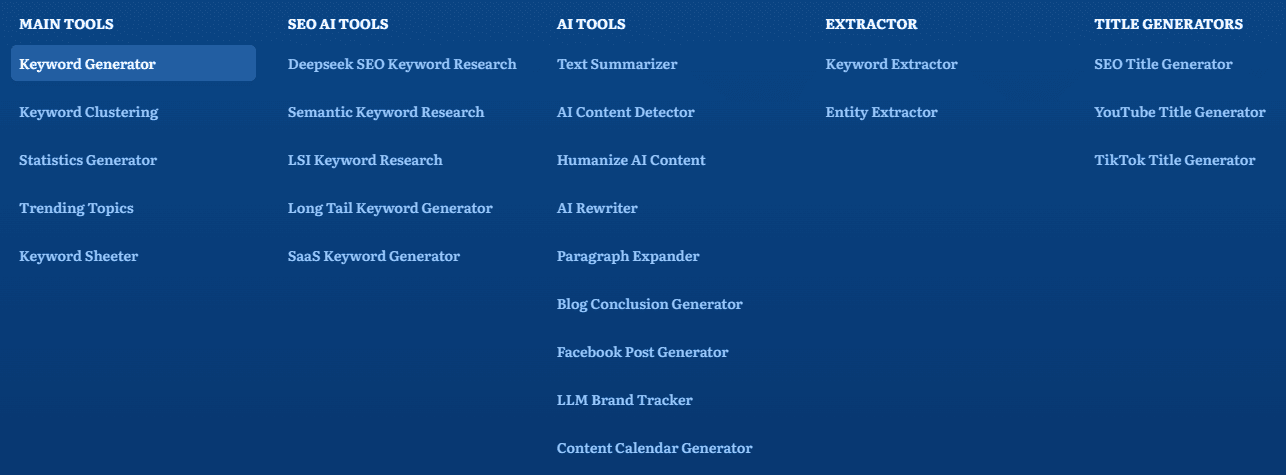How to Find Content Ideas: 8 Fresh Approaches for Creators

Every content creator knows the feeling… staring at a blank page, cursor blinking mockingly, while you try to formulate your next viral content idea for your blog or social media.
Consistent content creation is hard, and the soul-crushing pressure of needing to be perpetually brilliant across multiple platforms gets to us all sometimes.
If you’re running up against the dreaded content wall more often than you’d care to admit, here are some fresh new tools and ideas for content that will keep your calendar filled for months to come.
Chapters
8 Ways to Generate Endless Content Ideas

1. Answer Socrates: The Ultimate Free Content Idea Generator
Answer Socrates finds the questions real people are asking about any topic you can imagine.
Just enter your topic, pick a country and language, and hit ‘Search’. In just a few seconds, you’ll have hundreds – possibly thousands – of content ideas. And it’s totally free.

Now, this might sound like it’s sending you into a whole new kind of overwhelm with hundreds of new ideas to sort through, but don’t worry. Use Answer Socrates’ keyword clustering feature to group similar keywords into topics, and you have a list of usable, optimizable content ideas.
Here are some other features you need to try as part of your content creation process:
- Recursive Search: This tells you what people typically search for AFTER exploring your main topic – a whole new level of ideas to explore.
- Social Media Questions Generator: Plug your topic into this tool, and you’ll get a fresh list of interesting questions you can ask to generate tons of engagement with your audience.
- Trending Topics Discovery: Similar to Google Trends, this tool helps you identify trending topics in any niche before they explode.
- Title Generators: Nailing an eye-catching title can be the final hurdle in creating content, and this tool gets you over the line.
Put all of this together, and you have a tool that finds hundreds of relevant ideas for you, tells you how to approach covering them, and gives you titles that have the best chance of going viral.
All that’s left is for you to do what you do best: create the content.
Did we mention that all this is FREE with Answer Socrates?

2. Complaints Collector
This is exactly what it sounds like. Smart content creators keep a dedicated note where they record every complaint, frustration, or problem encountered related to their niche. These pain points are content gold.
That annoying experience with setting up email automation? It becomes the most successful tutorial. The confusion felt when reading contradictory advice about Instagram strategy? That transforms into a myth-busting series.
Everyday annoyances become the audience’s burning questions. The key is creating a systematic way to capture these complaints rather than letting them slip away.
3. Contrarian Calendar
The contrarian calendar approach involves marking common wisdom and typical advice in an industry by month, then deliberately creating content that questions or nuances these perspectives.
Everyone creating “New Year’s Resolution” content in January? Create “Why New Year’s Resolutions Fail (And What to Do Instead).” While others push “Summer Body” content in May, develop “Why Body Acceptance Matters More Than Summer Bodies.”
Taking the opposite stance (when done thoughtfully, not just for shock value) creates memorable content that stands out in a sea of sameness.
4. Repurposing Matrix
This approach involves creating a simple 3×3 grid that helps repurpose existing content in new ways:
- Rows: Content types (written, audio, visual)
- Columns: Content depths (brief, detailed, comprehensive)
Each cell represents a different content format. When a successful piece exists, plotting it on this matrix instantly reveals eight other ways to repurpose it.
A detailed written blog post can become a brief visual Instagram carousel, a comprehensive audio podcast episode, or a detailed YouTube tutorial. One idea, nine content pieces.
5. Audience Safari
Twice a month, conduct what smart creators call an “audience safari”, exploring the native habitats where target audiences hang out online when they’re not consuming the creator’s content.
This includes niche subreddits, Facebook groups, Discord servers, and even the comments sections of popular YouTube channels in the same space.
The goal isn’t passive observation; it’s categorizing the types of conversations happening:
- What problems are they trying to solve?
- What misconceptions keep coming up?
- What topics create the most debate?
- What resources do they recommend to each other?
Each of these categories becomes a content theme guaranteed to resonate because it’s based on real audience members expressing interest.
6. Content Gap Analysis

This method involves examining successful competitors’ content, but with a twist. Instead of copying what they’re doing, look for what they’re not doing.
The process works like this:
- Identify the top 5-10 competitors in your niche
- List their most successful content topics (based on engagement, shares, etc.)
- Note which topics they cover repeatedly
- More importantly, identify topics they rarely or never address
These gaps often represent untapped content opportunities. Perhaps these topics are difficult to research, require specialized knowledge, or simply haven’t been considered. Whatever the reason, these gaps present prime real estate for differentiated content.
Don’t forget to use Answer Socrates to generate a comprehensive list of topic ideas to help with this.
7. FAQ Expansion
This approach transforms basic frequently asked questions into full-fledged content pieces by applying the “5 Why” technique from engineering to content creation.
Start with a simple FAQ from your audience, product, or service. Then, ask “why” five times to go deeper:
- For example, starting with “How do I improve my website’s loading speed?”:
- Why is loading speed important? (User experience impact)
- Why does user experience impact business results? (Conversion rate connection)
- Why do small conversion rate changes matter? (Compound revenue effects)
- Why do businesses overlook these effects? (Short-term vs. long-term thinking)
- Why is technical optimization often deprioritized? (Skill gaps and resource allocation)
Each “why” question becomes its own content piece, transforming one simple FAQ into a five-part series that demonstrates genuine expertise.
8. Seasonal Anticipation
We all know how to plan around key seasonal events, but here’s the twist: focus on anticipatory content rather than in-the-moment content.
Instead of “Valentine’s Day Gift Ideas” in February, create “How to Drop Hints About What You Want for Valentine’s Day” in December.
This approach captures early searchers and planners before competition peaks, and positions the creator as helpfully ahead of the curve rather than jumping on the bandwagon with everyone else.
Content Ideation Doesn’t Have to Be Painful
The difference between struggling content creators and thriving ones isn’t talent or luck; it’s systems. With the right tools and processes, generating endless content ideas for social media and blogs becomes less of a creative burden and more of a strategic advantage.
The techniques shared here will help you break through idea blocks and create content that actually stands out from everyone else and resonates with your audience.
And the secret tool at the foundation of it all: Answer Socrates. Your future self, confidently planning content instead of staring at a blank page and procrastinating, will thank you.
Other Interesting Articles
Master the Art of Video Marketing
AI-Powered Tools to Ideate, Optimize, and Amplify!
- Spark Creativity: Unleash the most effective video ideas, scripts, and engaging hooks with our AI Generators.
- Optimize Instantly: Elevate your YouTube presence by optimizing video Titles, Descriptions, and Tags in seconds.
- Amplify Your Reach: Effortlessly craft social media, email, and ad copy to maximize your video’s impact.
The post How to Find Content Ideas: 8 Fresh Approaches for Creators appeared first on StoryLab.ai.


Deixe um comentário